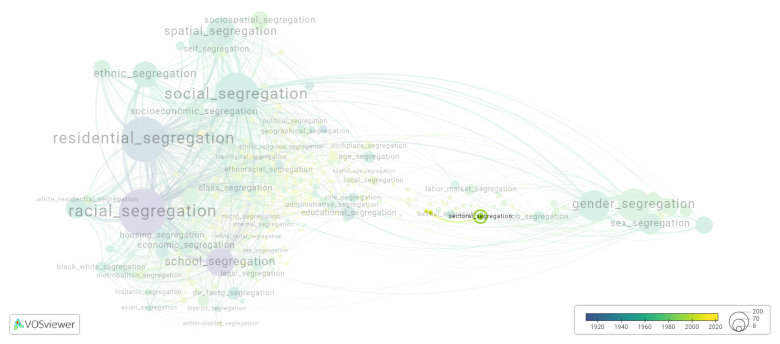Sectoral segregation
Date and country of first publication[1]
2003
Switzerland
Definition
Sectoral segregation refers to the concentration of certain industries or sectors of the economy in specific geographic areas or regions. It can occur at various levels, including national, regional, or local.
This phenomenon often occurs due to a combination of factors such as historical patterns of industrial growth, availability of natural resources, transportation infrastructure, labor availability, and specialization. As a result, certain regions may become known for their dominance in specific sectors, while other regions may lack representation or have a limited range of industries.
Sectoral segregation can have both positive and negative effects. On the positive side, it can lead to economies of scale and specialization, which can enhance productivity and competitiveness. For example, Silicon Valley in California is known for its concentration of technology and innovation companies, leading to a vibrant ecosystem and collaboration among firms.
However, sectoral segregation can also create economic disparities and vulnerabilities. If a region heavily relies on a particular industry and that industry faces a downturn, the local economy might suffer. Additionally, it can lead to uneven development and income disparities between regions.
Government policies can play a role in either promoting or addressing sectoral segregation. For example, policymakers may implement strategies to encourage diversification and attract industries to underrepresented areas. They may also invest in infrastructure and education to enhance the competitiveness of certain sectors in specific regions.
Overall, sectoral segregation refers to the concentration of industries or sectors in specific areas and can have both positive and negative implications on economic development and regional disparities.
Synonyms
The following terms are synonymous with sectoral segregation:
sectorial segregation.
References and literature addressing this segregation form under these synonymous terms can be found below.
See also
Related segregation forms
Sectoral segregation is frequently discussed in the literature with the following segregation forms:
gender segregation, sectoral gender segregation, horizontal segregation, job segregation, occupational segregation

This visualization is based on the study The Multidisciplinary Landscape of Segregation Research.
For the complete network of interrelated segregation forms, please refer to:
References
Notes
- ↑ Date and country of first publication as informed by the Scopus database (December 2023).
Sectoral segregation appears in the following literature
Müller T. (2003). Migration policy in a small open economy with a dual labor market. Review of International Economics, 11(1), 130-143. Blackwell Publishing Ltd.https://doi.org/10.1111/1467-9396.00373
Moore S. (2009). 'No matter what I did I would still end up in the same position': Age as a factor defining older women's experience of labour market participation. Work, Employment and Society, 23(4), 655-671. SAGE Publications Ltd.https://doi.org/10.1177/0950017009344871
Van Puyenbroeck T., De Bruyne K., Sels L. (2012). More than 'Mutual Information': Educational and sectoral gender segregation and their interaction on the Flemish labor market. Labour Economics, 19(1), 1-8. https://doi.org/10.1016/j.labeco.2011.05.002
Périvier H. (2014). Men and women during the economic crisis employment trends in eight European countries. Revue de l'OFCE, 133(2), 41-84. Presses de Sciences Po.https://doi.org/10.3917/reof.133.0041
Périvier H. (2014). Men and women during the economic crisis employment trends in eight European countries. Revue de l'OFCE, 133(2), 41-84. Presses de Sciences Po.https://doi.org/10.3917/reof.133.0041
Moldovan O. (2016). Representative bureaucracy in Romania? Gender and leadership in central public administration. Transylvanian Review of Administrative Sciences, 2016(48), 66-83. Universitatea Babes-Bolyai.https://doi.org/
Wemlinger E., Berlan M.R. (2016). Does Gender Equality Influence Volunteerism? A Cross National Analysis of Women’s Volunteering Habits and Gender Equality. Voluntas, 27(2), 853-873. Springer New York LLC.https://doi.org/10.1007/s11266-015-9595-x
Boll C., Rossen A., Wolf A. (2017). The EU Gender Earnings Gap: Job Segregation and Working Time as Driving Factors. Jahrbucher fur Nationalokonomie und Statistik, 237(5), 407-452. De Gruyter Oldenbourg.https://doi.org/10.1515/jbnst-2017-0100
Rugina S. (2019). Female entrepreneurship in the Baltics: formal and informal context. International Journal of Gender and Entrepreneurship, 11(1), 58-74. Emerald Group Holdings Ltd..https://doi.org/10.1108/IJGE-05-2018-0055
Seneviratne P. (2019). Married women's labor supply and economic development: Evidence from Sri Lankan household data. Review of Development Economics, 23(2), 975-999. Blackwell Publishing Ltd.https://doi.org/10.1111/rode.12581
Borrowman M., Klasen S. (202). Drivers of Gendered Sectoral and Occupational Segregation in Developing Countries. Feminist Economics, 26(2), 62-94. Routledge.https://doi.org/10.1080/13545701.2019.1649708
Barba I., Iraizoz B. (202). Effect of the great crisis on sectoral female employment in Europe: A structural decomposition analysis. Economies, 8(3), -. MDPI AG.https://doi.org/10.3390/ECONOMIES8030064
Barba I., Iraizoz B. (202). Effect of the great crisis on sectoral female employment in Europe: A structural decomposition analysis. Economies, 8(3), -. MDPI AG.https://doi.org/10.3390/ECONOMIES8030064
Salonen L., Kähäri A., Pietilä I. (202). Finland. Extended Working Life Policies: International Gender and Health Perspectives, 251-260. Springer International Publishing.https://doi.org/10.1007/978-3-030-40985-2_18
Lewandowski P., Lipowska K., Magda I. (2021). The Gender Dimension of Occupational Exposure to Contagion in Europe. Feminist Economics, 27(1-2), 48-65. Routledge.https://doi.org/10.1080/13545701.2021.1880016
Batchuluun A. (2021). The gender wage gap in Mongolia: Sectoral segregation as a driving factor. Review of Development Economics, 25(3), 1437-1465. John Wiley and Sons Inc.https://doi.org/10.1111/rode.12763
Piłatowska M., Witkowska D. (2022). Gender Segregation at Work over Business Cycle Evidence from Selected EU Countries. Sustainability (Switzerland), 14(16), -. MDPI.https://doi.org/10.3390/su141610202
